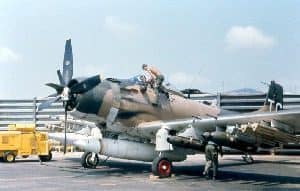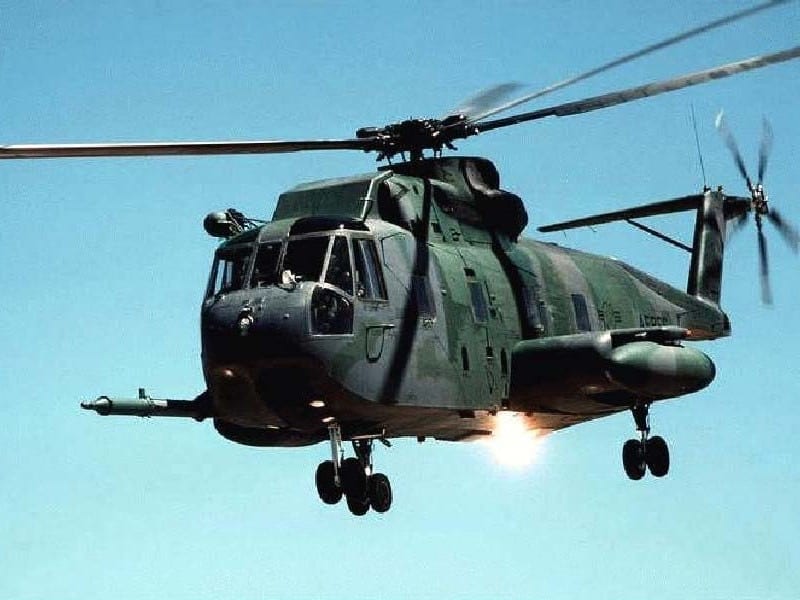By Ptero John “Bear” Moseley, Aviator 743
The goal of the combat rescue and recovery units during the Vietnam conflict was to get to those in peril before the enemy did. Whether the mission was an extraction or the pickup of a downed airman, each time they were successful it was a win! This was called a “save,” but a “save” was much more than a statistic to these men. A “save” was a person, and they took it personally. There were 11 Coast Guard Aviators that flew with these rescue forces in Vietnam between 1968 and 1972. They were all volunteers – they were all highly praised. The following relates a mission that involved two of these gentlemen and illustrates that if at all possible – No one was left behind.
October 24, 1969:
Misty-11, an Air Force F-100F (Fast FAC), was designating targets along the Ho Chi Min Trail, for ground interdiction strikes when he experienced engine failure due to antiaircraft fire. A MAYDAY was broadcast and the two crewmen ejected at low altitude and parachuted down into the mountainous Laotian jungle terrain. Misty A, Capt Jack Clapper and Misty B, 1Lt Don Mueller were separated by about 800 yards due to the programmed delay in the ejection sequence between the front and rear ejection seats. Each was equipped with a battery-powered radio and was contacted by Nail 07 (FAC), who had heard their pre-ejection call and was working in the area. He said that he would notify search and rescue. Misty B (Muller) informed Misty A and the FAC that his leg was badly broken.
In less than two hours a rescue team consisting of two A-1 Skyraiders (Code name Sandy) and two HH-3E Jolly Green Giant helicopters (Code name Jolly) were on scene. The helicopters went into orbit. One helicopter referred to as “low Bird” would make the rescue attempt and the second referred to as “high bird,” would remain in a 3000 ft orbit as backup. Before sending in “low bird” the A-1s trolled the area but their repeated passes brought no response.
Lt. Dick Butchka, USCG, in the high bird slot, watched as Capt. Charles Langham USAF, descend for the recovery. Langham came to a hover over Misty 11B and lowered his PJ, TSGT Donald G Smith by hoist. Smith immediately had the downed airman on the forest penetrator and gave the cable-up signal. Less than a minute had elapsed. When the penetrator was approximately10 feet off the ground the helicopter came under heavy fire. Butchka saw three sides of the blind canyon twinkling. Langham had flown into a “flak-tap.” The A-1s rushed in to suppress the fire, but the opening volley had shot the hoist assembly off its mounting, sending it crashing into the flight engineers chest. Realizing the hoist was inoperative the flight engineer hit the switch cutting the cable and yelled to Langham to pull off.
Seeing Langham’s aircraft smoking and throwing fluid, Butchka told him to put it on the ground. Langham searched for a clear spot and put the aircraft into a small bowl shaped valley. Meanwhile, Butchka had punched off his aux tanks and had begun an emergency descent. Dick said he knew that time was of the essence and he had to get Langham and his crew before “the bad guys” did. The Jolly crew jumped out of the helicopter into the elephant grass looking up for a high bird. They did not have far to look. Butchka’s helicopter was in a 20-foot hover on the left side of Langham’s with its cable waiting. Butchka expected ground fire at any minute.
With the men safely on board, the next problem was getting out of there. Butchka did not want to go back out the way he came in because of heavy enemy fire. It was hot and humid; the pressure altitude was high, and the only other way out presented him with a vertical face of about 130 feet. It was decision time! Butchka said; “I headed for the face, – pulled every bit of power I had, didn’t worry about over torque, and with a little bit of airspeed, — drooped the rotor to 94%, — and just cleared the top.” As he cleared the ridge line the Jolly immediately came under heavy ground fire from a different direction. The helicopter was hit but the damage was not severe. Butchka proceeded to Da Nang.
There were now three men on the ground to rescue; Misty A, Misty B and the PJ, TSGT Smith. Smith directed air strikes that bracketed his position and that of Misty A. Jolly 76, out of Udorn made three recovery attempts, but each time he received intense ground fire, resulting in extensive battle damage. Jolly 76 had to withdraw.
Later that afternoon the Jollys tried again. LTJG Rob Ritchie USCG was “low Bird” in Jolly 15. Rob said; “The previous attempts that day were all into the wind approaches. I chose a downwind approach because all indications were the ‘bad guys’ were set up for us to come into the wind and were waiting.” The Sandys made suppression runs and laid smoke as had been requested. Ritchie used the smoke for cover, swooped in fast and quickly put the aircraft into a hover over Sergeant Smith and got both Smith and Misty B on board with only slight damage to the aircraft. During Ritchie’s next approach to pick up Misty A they began taking very heavy ground fire on the way in. The element of surprise was no longer there and the North Vietnamese had repositioned. Sandy lead called the approach off and both AD-1s made several suppression runs.
Ritchie commenced his third approach immediately after the suppression runs. He said it was much quieter this time and he came to a hover over Misty 11 A. As the penetrator went down the ground fire became much heavier and the helicopter was taking numerous hits. The utility hydraulics to the hoist was disabled due to ground fire damage to a pressure line and fluid flow was lost. Unable to complete the pickup Ritchie exited the area.
Two additional tries to pick up Misty A were made to no avail. A third attempt was made while a tropical thunderstorm was passing through and as the storm began to subside the Jollys were able to pick up Misty 11A.
The Air Rescue forces in Southeast Asia didn’t get all of the downed airmen but no one can say they didn’t try. They did get 3.883 and provided the world with thousands of examples of unselfish humanity. A report prepared by the Air Force Inspection and Safety Center, summarizing helicopter use in combat rescues, noted that during the Vietnam War, between 1965 and 1972, helicopters came under significant hostile fire in 645 opposed combat rescue operations involving downed aircraft. Crews were rescued in six hundred and one, or 93 percent, of these cases. This was not accomplished without cost. The 37Th ARRS lost 28 men including Lt. Jack C. Rittichier USCG.
Air Force Skyraiders in Southeast Asia are probably best remembered for their support of search and air rescue missions. Operating under the call sign Sandy, the A-1’s ability to fly over a downed Airman for an extended period complemented its massive firepower. Armament consisted of four 20mm cannons and a wide assortment of bombs, rockets, and gun pods Whereas jet aircraft often had to leave an area for refueling or rearming, the Sandys provided nearly continuous suppressing fire until helicopters could extract downed Airmen.
The U.S. Air Force developed the Sikorsky HH-3E helicopter, nicknamed the “Jolly Green Giant,” to perform combat search and rescue (CSAR) to recover downed Airmen during the Southeast Asia War. The HH-3E was the first air-refuelable helicopter to be produced. The HH-3E’s retractable fuel probe and external fuel tanks gave it the capability to conduct CSAR operations anywhere in the Southeast Asia Theater of operations. It was armed with two 7.62 millimeter M60 machine guns; had self sealing fuel tanks and carried titanium armor plating.
Editorial Comment:
Many of our present members are familiar with the fact that Coast Guard Aviators were Jolly Greens, but most are probably not familiar with the details. Most likely, among the active duty folks, knowledge of this chapter in Coast Guard Aviation is limited. Between 1968 and 1972 there were eleven, all volunteers, who served. They performed with distinction and were highly decorated. Four of these gentlemen; LCDR Lonnie Mixon, LT Lance Eagan, LT Jack Rittichier and LTJG Rob Ritchie were awarded Silver Stars. These are the only four Silver Stars that have been awarded to Coast Guard Aviators in the performance of aviation duties.
General Howell M. Estes, Jr., USAF, Commander, Military Airlift Command, made the following statement about them:
“I am personally aware of the distinguished record achieved by the Coast Guard pilots flying in combat with our Jolly Greens. They have flown many difficult and challenging missions and have consistently demonstrated their unreserved adherence to both our mottoes, — Always Ready and That Others May Live –They are indelibly inscribed in the permanent records of the stirring and moving drama of combat air crew recovery in Southeast Asia.”
The performance level of these Coast Guard Aviators was of such a high level that they were inducted as a group into the Coast Guard Aviation Hall of Honor.
More about Coast Guard Aviators involvement in Vietnam


